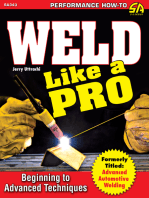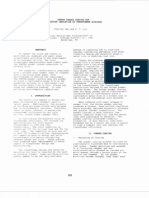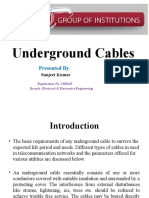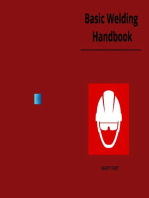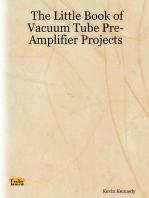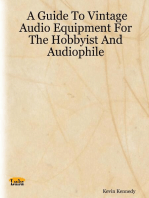0 ratings0% found this document useful (0 votes)
16 viewsWinding Techniques
Winding Techniques
Uploaded by
hammad engineeringCopyright:
© All Rights Reserved
Available Formats
Download as DOCX, PDF, TXT or read online from Scribd
Winding Techniques
Winding Techniques
Uploaded by
hammad engineering0 ratings0% found this document useful (0 votes)
16 views5 pagesOriginal Title
winding techniques
Copyright
© © All Rights Reserved
Available Formats
DOCX, PDF, TXT or read online from Scribd
Share this document
Did you find this document useful?
Is this content inappropriate?
Copyright:
© All Rights Reserved
Available Formats
Download as DOCX, PDF, TXT or read online from Scribd
Download as docx, pdf, or txt
0 ratings0% found this document useful (0 votes)
16 views5 pagesWinding Techniques
Winding Techniques
Uploaded by
hammad engineeringCopyright:
© All Rights Reserved
Available Formats
Download as DOCX, PDF, TXT or read online from Scribd
Download as docx, pdf, or txt
You are on page 1of 5
Presentation on theme: "Winding technique Just like oil
filled transformers , there are varieties of windings in
cast resin transformers too. Reliability & ease of
manufacturing."— Presentation transcript:
2 Winding techniqueJust like oil filled transformers , there are varieties of
windings in cast resin transformers too.Reliability & ease of manufacturing is
aslo to be considered while deciding on any winding method.Major types in cast
resin transformer windings methods are..Low voltage windingFoil winding using
thin stripLayer winding by using Rectangular wires.High Voltage windingFoil disc
windingLayer winding by using Round/Rectangular wire
3 Winding technique LV Foil winding:
It uses a single piece of thin strip as conductor. Width of the foil is equal to
length of the winding.This conductor strip (foil) wound along with a pre-
impregnated interlayer insulation. During curing process foil and insulation are
bonded together to form a rigid block. The LV coil becomes self supporting
against forces.Later the coil is impregnated with resin for environmental
protection.Eddy losses in the thin foil are very less compared to thick
rectangular wires,so windings made with foil are cooler than other types.Foil
winding minimizes the axial forces during short circuit , since currents in the
winding are adjusted to the ampere turns in the high voltage winding.Is simple
introduce cooling duct without decreasing the mechanical stregnt.It is easy and
quick to manufacture this type of winding.
4 Winding technique Line terminal
Terminals complitely welded on all conductur heightBushings fixed to clampsAl
cooling duct
5 Winding technique LV layer winding:
Multiple strands of rectangular wire is used in this method.Conductor thickness
is generally high to limit number of strands. So eddy & stray losses are high in
this construction.Transposition of conductors is mandatory to avoid the
circulating currents in the windings.Transposition is a tedious and sensitive
process. If not done carefully inter-strand faults cause dielectric failures and hot
spots in the winding.Manufacturing the multistrand layer winding is
complicated.Winding is not balanced very well with the High voltage winding.
Axial forces present during short circuit conditions.It is not a self standing
construction, requires support by cylinders. sometimes it is casted with moulds.
6 Winding techniqueFoil WindingLayer Winding
7 Winding technique HV Foil disc winding:
Even distribution of voltage along the height of the winding is important for High
Voltage winding.Foil disc winding is a winding technique which achives this
requirement.Thin foils of required width are wound with interlayer insulation
between them. Each layer is a turn , so voltage stress is minimized.Total turns
are devided between many discs , so voltage gradient between discs is also
low.This can be made on automated machines , which gives accuracy & speed.
8 Winding techniqueHV Foil disc winding:
9 Winding technique HV wire winding:
Several winding methods are followed in wire windingMultilayer winding ,
random winding , wire discs winding etc. are some methods.Generally round
wire/rectangular wire is used for winding based on the rating.Whatever the
method followed , uniform voltage distribution is not possible in wire type
windings.This affects the impulse withstand strength.Voltage stress increases
progressively towards the end of layer.
10 Winding techniqueFoil discsRandomWire discsMultilayer
11 Winding technique Foil disc winding Homogeneous distribution
Wire disc windingNon Homogeneous distribution
12 Winding technique What TMC Follows:
TMC follows Foil disc winding technique conisdering its uniform voltage
distribution.Example of 1600kVA transformer 36kV class.Impulse level
170kVMaximum voltage between discs , in case of impulse , 17kV with 14mm of
resin.Breakdown voltage of TMCRES resin 40kV/mm at 20°C
13 Filled Vs Unfilled system
Unfilled system , as the name suggests, does not use any type of fillers. Resin
and Hardner are the main components.Unfilled system is used where very low
viscosity is a requirement Ex: very small coils used in electrionicsUnfilled
system can have smaller gaps in the coils , since the resin has low
viscosity.Casted block in the unfilled system is manufacture with glass
Fibres.Fibres needs to be completely impregnated for achieving the desirable
dielectric & mechanical strength.Fibres , if not impregnated properly , causes
voids in the coil that results in dielectric failures.This system can be used with
good results up 12 kV class. When the voltage stress is not very high.
14 Filled Vs Unfilled system
Filled system means , resin & hardner are added with fillers like
quartz/silica/aluminium hydroxide etc.Fillers provideFlame retardency, self
extinguishing & arc resistanceIncreases Thermal conductivityIncreases Thermal
shock resistanceReduce the shrinkageImprove adhesion to the conductorBrings
the coefficient of thermal expansion more close to conductor material.Adding
fillers increases the viscosity. But viscosity can be reduced by warming the resin
mixture.
15 Filled Vs Unfilled system
What TMC Follows:Filled system (or) Unfilled system is to be decided based on
the product requirements.TMC uses Filled resin system to fulfill the product
requirements as mentioned above.TMC products has C2-E2-F1 certificated.TMC
supplies transformers suitable for storage upto -50° C , which proves the
strength of filled system.Insulation material used in the filled system are self
sufficient for dielectric strength. Impregantion by resin is not required.
16 Impregnated Vs Cast Windings
Impregnated windings :Other names for this construction are
Openwound/Openventilated windings/VPI/VPEDoes not require any moulds for
winding. Flexibility in design.The winding construction is simillar to disc
windings of oil filled transformers.Windings are immersed in resin and then
cured. Resin coating on conductors is less than a milli meter.provides clear view
of the windings. Fault location is easy.Heat dissipation directly from
windings.Strength aganist short circuits is poor.Interspace between winding
discs is air. Limited dielectric strength due to presence of air between discs.
17 Impregnated Vs Cast Windings
....contdSince windings are exposed to atmosphere around them , dust collection
on surface of conductors is possible.Mositure accumaltes on windings , if
transformers are stored.Transformers can not be switched on immedialtely after
long shut downs.Partial discharges possibility as air is the insulating
medium.Open wound transformers are not conisdered as maintenance free.
18 Unfilled Cast windings
Impregnated Vs Cast WindingsFilled Cast windingsUnfilled Cast
windingsImpregnated windings
19 Impregnated Vs Cast Windings
Filled Cast windings :Unique feature of cast resin transformer is conductors of
HV winding are completely encapsulated in a cast resin block which has a
smooth surface.They require moulds to encapsule the windings.Uses
round/rectangular wire (or) Foil as the winding conductors.Can use both
Aluminium/Copper conductors.Foil disc is most widely used option for HV
winding.Windings are made on mandrel ,moulds are fitted, Resin is filled and
then cured.Cast resin coils are non hygroscopic.Transformer can be switched on
after long shut downs.
20 Impregnated Vs Cast Windings
...contdCast Coils are perfectly mositure proof , dust proof & has very high
reliability.Very strong against short circuits as windings are encapsulated.Heat
dissipation surface area increases due to the encapsulation of the windings.Low
Partial discharges since gap between disc is filled with resin.Cast resin
transformers are practically maintenance free.Cast winding conductors are not
visible to naked eyes.Repairability of windings is not an issue , if a transformer
fails it is never repaired by an user.
21 Impregnated Vs Cast Windings
What TMC Follows:TMC manufactures HV windings using mouldLV winding is
made with AL/CU Foil. Mould are not used for casting. They are
Impregnated.Being low voltage , LV winding does not require castingInsulation
used in LV winding is pre impregnated with resins. During curing of LV winding
insulation and conductor forms a rigid block. Later LV winding is impreganted
with resin for environmental protection.Such LV windings are suitable for
installation under tropical or saline environmnets.If customer requires cast LV
winding , TMC supplies.
22 Copper Vs AluminiumBoth are used as conductors of electricity & long
history of being used as winding conductors for transformes.Copper is the
preferred conductor during initial days of transformer manufacturing, due to it’s
ready availability.AL usage became prominent during world war2 due to non
availability of Copper & improvement in metullargical processes of
Aluminium.We can achieve same performance parameters by using Allumninum
(or) Copper windigs.We can compare both conductors byElectrical
PropertiesThermal PropertiesMechanical Properties
23 Copper Vs Aluminium
24 Copper Vs Aluminium Electrical Properties:
Copper has lesser resistivity. To achive same ohmic losses times higher cross
section of Aluminium to be used.Core cross section to be increased to offset the
volume increase due to Aluminium conductor.Specific weight of Aluminium is
much lesser than copper. So weight of Aluminium is 50-55% of weight of
copper.Increase in core weight is compesated by reduction in conductor
weight.AL transforer will have almost equal weight as the copper
transformer.Volume is slightly higher than the copper transformer. (5-10%)We
can achieve same performance paramenters like noload/load losses,
Impedance , temperature rise of windings using AL conductor.
25 Copper Vs Aluminium Thermal Properties:
Melting point of Aluminium (665°C) is considerably lower than of Copper
(1085°C).The service tempearature of cast resin transformer is 155°C for class F
and 180° C for class H transformers.So,Melting point is not of
importance.Thermal conductivity of Aluminium is lower than copper.But while
calculating thermal gradients between winding and ambient air whole coil is
take as a block. So heat dissipation does not depend solely on the Thermal
conductivity.Surface area of Aluminium is higher than Copper for same losses.
Moreover, specific heat of Aluminium is more than copper.Higher surface area
and higher specific heat makes Aluminium coils cooler than copper coils for
same losses.
26 Copper Vs Aluminium ....contd
This is an advantage for longer life of insulation and also during short time
overloads.Incase of resin encapsulated transformers , it is very important that
the co-efficient of thermal expansion of conductor and resin block needs to be
close. If they differ too much, cracks develop during varying load
cycles.Aluminium co-efficient is close to the resin mixture, which makes this
conductor more suitable for cast coils.
27 Copper Vs Aluminium Mechanical Properties :
Conductors in the transformers are stressed during the fault conditions.The
forces generated during faults are expressed as compression , tesion and
bending between coil supports.Breaking strength of Aluminium is lesser than the
copper. It is compensated by the higher cross section of Aluminium used for
same current.Further High voltage windings are encapsulated in the resin block.
Hence , the mechanical strength is provided by the resin.For Low voltage Foil
windings, using preimpregnated insulation and curing it subsequently makes the
coil as a rigid block to withstand forces.
28 Copper Vs Aluminium Other Considerations: .... contd
Aluminium windings can be designed to have same mechanical integrity as of
copper windings.Other Considerations:Larger surface area of the Aluminum
windings improves the series capacitance , which is favourable for Impulse
voltage withstand.Improvements in jointing techniques has made Aluminum to
easily and reliably join with copper (or ) other Aluminium conductors.Price of
Copper is very much volatile and ~ 3,5 times of the price of Aluminium.
29 Copper Vs Aluminium What TMC Follows:
It can be concluded that medium power transformers upto 20 MVA can be
manufactured with Aluminium windings without any difficulty.Aluminium
windings are default for TMC.Aluminium winding transformers are cheaper by %
for same performance.Copper winding transformers will be supplied by TMC , if
customer requires them.
You might also like
- Transformer BasicsPDFDocument64 pagesTransformer BasicsPDFShrikant Kajale100% (1)
- Transformer Basics (Excellent For Practical Purpose)Document40 pagesTransformer Basics (Excellent For Practical Purpose)Sandeep Kumar100% (3)
- Weld Like a Pro: Beginning to Advanced TechniquesFrom EverandWeld Like a Pro: Beginning to Advanced TechniquesRating: 4.5 out of 5 stars4.5/5 (6)
- Auto-Transformer Design - A Practical Handbook for Manufacturers, Contractors and WiremenFrom EverandAuto-Transformer Design - A Practical Handbook for Manufacturers, Contractors and WiremenRating: 4 out of 5 stars4/5 (2)
- BS en 12201 3 PDFDocument32 pagesBS en 12201 3 PDFssdprojects Rex75% (4)
- Construction of TransformerDocument33 pagesConstruction of TransformervurumuuNo ratings yet
- LTL Transformers (PVT) LTD: Field Visit ReportDocument12 pagesLTL Transformers (PVT) LTD: Field Visit ReportPathum Sudasinghe100% (3)
- Transformer Installation, Commissioning, Operation and MaintenanceDocument40 pagesTransformer Installation, Commissioning, Operation and MaintenancejunclarcNo ratings yet
- Types of Wires Cable PDFDocument21 pagesTypes of Wires Cable PDFRájDèép TrìpâţhíNo ratings yet
- Enercon Finals Assignment 5Document18 pagesEnercon Finals Assignment 5Ezekiel Brizuela100% (2)
- Transformer Basics To Those Unfamiliar With Transformer Manufacturing, Terms Such As Fish, Kraft, NaturalDocument6 pagesTransformer Basics To Those Unfamiliar With Transformer Manufacturing, Terms Such As Fish, Kraft, NaturalluroguitaNo ratings yet
- Birla Vishvakarma MahavidyalayaDocument22 pagesBirla Vishvakarma MahavidyalayaRajeshNo ratings yet
- Alum 1Document20 pagesAlum 1Bharat G HegdeNo ratings yet
- Topic 4 - CablesDocument20 pagesTopic 4 - CablesVictorNo ratings yet
- CATCTCESSEXITALYed 3 Rev 1Document38 pagesCATCTCESSEXITALYed 3 Rev 1Kailash ChandraNo ratings yet
- VORTEX Powder Coating For Conductor Insulation of Transformer WindingsDocument4 pagesVORTEX Powder Coating For Conductor Insulation of Transformer WindingsYogesh ChadawatNo ratings yet
- Submision of Building ServicesDocument24 pagesSubmision of Building ServiceskusumchitikaNo ratings yet
- Copper Braid and Laminated ConnectorDocument8 pagesCopper Braid and Laminated ConnectorUjjwal Shah100% (1)
- Polyphase TransformersDocument7 pagesPolyphase TransformersRahul RaiNo ratings yet
- TMC - TransformersDocument30 pagesTMC - TransformersbrmamorNo ratings yet
- Prevost 1989Document5 pagesPrevost 1989sajjad_pirzadaNo ratings yet
- Underground CablesDocument46 pagesUnderground CablesmselvamNo ratings yet
- Underground CabalesDocument46 pagesUnderground Cabalesrimzimwaghela4No ratings yet
- Transformer Design-01Document21 pagesTransformer Design-01Anoop BhattacharyaNo ratings yet
- Ppt. On Transformer WindingsDocument23 pagesPpt. On Transformer WindingsSandhya Rathore100% (4)
- Transformer EngineeringDocument12 pagesTransformer EngineeringAvinash LalNo ratings yet
- Transformers SWDocument7 pagesTransformers SWBryan FerrolinoNo ratings yet
- TransformerDocument8 pagesTransformersbpathiNo ratings yet
- Cable Construction Part 1Document5 pagesCable Construction Part 1Jesus RodriguezNo ratings yet
- Dry Type TransformersDocument5 pagesDry Type TransformersPrashant TrivediNo ratings yet
- T'Mer Basic &bushingDocument3 pagesT'Mer Basic &bushingjay shahNo ratings yet
- Underground Cables: Presented byDocument54 pagesUnderground Cables: Presented byAdelChNo ratings yet
- Cable Construction & Cable Selection-Part:1Document4 pagesCable Construction & Cable Selection-Part:1A. HassanNo ratings yet
- Cast Resin TransformerDocument16 pagesCast Resin TransformerMahadi HassanNo ratings yet
- Underground Cables: Atmiya Institute of Technology & ScienceDocument35 pagesUnderground Cables: Atmiya Institute of Technology & ScienceLaveen Raghunam100% (2)
- UndergroundcablesDocument31 pagesUndergroundcablesHARIS AHAMMEDNo ratings yet
- Underground CablesDocument50 pagesUnderground CablesSanjeet KumarNo ratings yet
- Underground Cable System DesignDocument25 pagesUnderground Cable System DesignJayvee BustardeNo ratings yet
- Types of Wires and CablesDocument23 pagesTypes of Wires and CablesTanya75% (4)
- RF Mosfet BasicsDocument21 pagesRF Mosfet BasicsStephen Dunifer100% (5)
- Types of WIRESDocument7 pagesTypes of WIRESshadowsama100% (1)
- Underground Cables (Done)Document17 pagesUnderground Cables (Done)Sk Munwar BabuNo ratings yet
- F2017019044-Huzaifa Tahir-Assignment#01Document5 pagesF2017019044-Huzaifa Tahir-Assignment#01Huzaifa TahirNo ratings yet
- CablesDocument43 pagesCablesdasaridakshyani1704No ratings yet
- Assignment IT101Document3 pagesAssignment IT101khojizekiahNo ratings yet
- Wiring SystemsDocument16 pagesWiring Systemswafulaabraham180% (1)
- Transformer: A. Transformer Basic TheoryDocument14 pagesTransformer: A. Transformer Basic TheoryBe Sar WicaksonoNo ratings yet
- Soldering Electronic Components 2nd EditionFrom EverandSoldering Electronic Components 2nd EditionRating: 3 out of 5 stars3/5 (2)
- Small Dynamos and How to Make Them - Practical Instruction on Building a Variety of Machines Including Electric MotorsFrom EverandSmall Dynamos and How to Make Them - Practical Instruction on Building a Variety of Machines Including Electric MotorsNo ratings yet
- Industrial Power Transformers: Selection, Installation, Advanced Maintenance and ReliabilityFrom EverandIndustrial Power Transformers: Selection, Installation, Advanced Maintenance and ReliabilityNo ratings yet
- A Short Guide to the Types and Details of Constructing a Suspension Bridge - Including Various Arrangements of Suspension Spans, Methods of Vertical Stiffening and Wire Cables Versus Eyebar ChainsFrom EverandA Short Guide to the Types and Details of Constructing a Suspension Bridge - Including Various Arrangements of Suspension Spans, Methods of Vertical Stiffening and Wire Cables Versus Eyebar ChainsNo ratings yet
- Induction Coils - How To Make, Use, And Repair Them: Including Ruhmkorff, Tesla, And Medical Coils, Roentgen, Radiography, Wireless Telegraphy, And Practical Information On Primary And Secodary BatteryFrom EverandInduction Coils - How To Make, Use, And Repair Them: Including Ruhmkorff, Tesla, And Medical Coils, Roentgen, Radiography, Wireless Telegraphy, And Practical Information On Primary And Secodary BatteryRating: 5 out of 5 stars5/5 (2)
- A Guide to Vintage Audio Equipment for the Hobbyist and AudiophileFrom EverandA Guide to Vintage Audio Equipment for the Hobbyist and AudiophileNo ratings yet
- 37 CHC Jammamalamadugu (Kadapa)Document17 pages37 CHC Jammamalamadugu (Kadapa)kiran raghukiranNo ratings yet
- Summary of Master Programme - 30.05Document9 pagesSummary of Master Programme - 30.05hmdineshNo ratings yet
- SAIL RESIDENCES - Project Briefing - 2023.01.13Document30 pagesSAIL RESIDENCES - Project Briefing - 2023.01.13Ritz Cruz ClementeNo ratings yet
- Proposed Utilities Piping & Fittings of Soaps & Cometics PlantDocument1 pageProposed Utilities Piping & Fittings of Soaps & Cometics PlantLuigi Andrew MercadoNo ratings yet
- 6FX5002 2AH00 1BF0 Datasheet enDocument2 pages6FX5002 2AH00 1BF0 Datasheet enTraian SerbanNo ratings yet
- Free Deer Stand PlansDocument10 pagesFree Deer Stand PlansProfa SmithNo ratings yet
- EJMA The Expansion Joint Manufacturers Association Standards 2008 (9th Ed)Document239 pagesEJMA The Expansion Joint Manufacturers Association Standards 2008 (9th Ed)Samuel Yu LiuNo ratings yet
- International Limited: Certificate of Visual Examination and MpiDocument2 pagesInternational Limited: Certificate of Visual Examination and MpiMichael OkwuwaNo ratings yet
- Api Products: API Approved Swivel JointsDocument3 pagesApi Products: API Approved Swivel JointsLeon PeterNo ratings yet
- WELD-Electrode Products Comparability ChartDocument7 pagesWELD-Electrode Products Comparability ChartpeterNo ratings yet
- Fgma Bs 6180 FinalDocument9 pagesFgma Bs 6180 FinalantoineNo ratings yet
- Steel and Cast Iron Standards EN 10253Document2 pagesSteel and Cast Iron Standards EN 10253NicolaeNo ratings yet
- Bridge Construction TechniquesDocument71 pagesBridge Construction TechniquesAneetha VNo ratings yet
- Strain Wedge Model Capability of Analyzing Behavior of Laterally Loaded Isolated Piles, Drilled Shafts, and Pile GroupsDocument10 pagesStrain Wedge Model Capability of Analyzing Behavior of Laterally Loaded Isolated Piles, Drilled Shafts, and Pile GroupsAhmed RamadanNo ratings yet
- Purchase Spec. For Tubes (Sa213 TP321)Document5 pagesPurchase Spec. For Tubes (Sa213 TP321)Daison PaulNo ratings yet
- Steam Jet Refrigeration SystemDocument6 pagesSteam Jet Refrigeration Systembbaytl100% (1)
- Retaining WallsDocument12 pagesRetaining WallsSIZA THE POETNo ratings yet
- Tahiti Housing: Santa Monica, CaliforniaDocument11 pagesTahiti Housing: Santa Monica, CaliforniaAnmol ChughNo ratings yet
- 201 Q 1heshamDocument14 pages201 Q 1heshammohamed tharwatNo ratings yet
- DWHP Twin Wall Flue SystemsDocument11 pagesDWHP Twin Wall Flue SystemsAirtherm Eng LtdNo ratings yet
- EN 61232-1995 - en Aluminium Clad SteelDocument18 pagesEN 61232-1995 - en Aluminium Clad SteelMTIWARINo ratings yet
- Bubble Deck Slab: November 2018Document40 pagesBubble Deck Slab: November 2018Kiran GowdaNo ratings yet
- Azas Teknik Kimia IIDocument23 pagesAzas Teknik Kimia IIArsendi NugrahaNo ratings yet
- Mekanika Material Latihan Soal Untuk Jurusan Teknik FisikaDocument17 pagesMekanika Material Latihan Soal Untuk Jurusan Teknik FisikaEsther Kezia SimanjuntakNo ratings yet
- Labour and Equipment ProductivityDocument8 pagesLabour and Equipment ProductivityGerry RilyoNo ratings yet
- Pert CPM CompacDocument123 pagesPert CPM CompacNHA-Technical BalagtasNo ratings yet
- CE325 - 06 Immediate SettlementDocument45 pagesCE325 - 06 Immediate SettlementRobert PrinceNo ratings yet
- What, Why & How?: Finishing Concrete FlatworkDocument2 pagesWhat, Why & How?: Finishing Concrete FlatworkhemantrulzNo ratings yet


